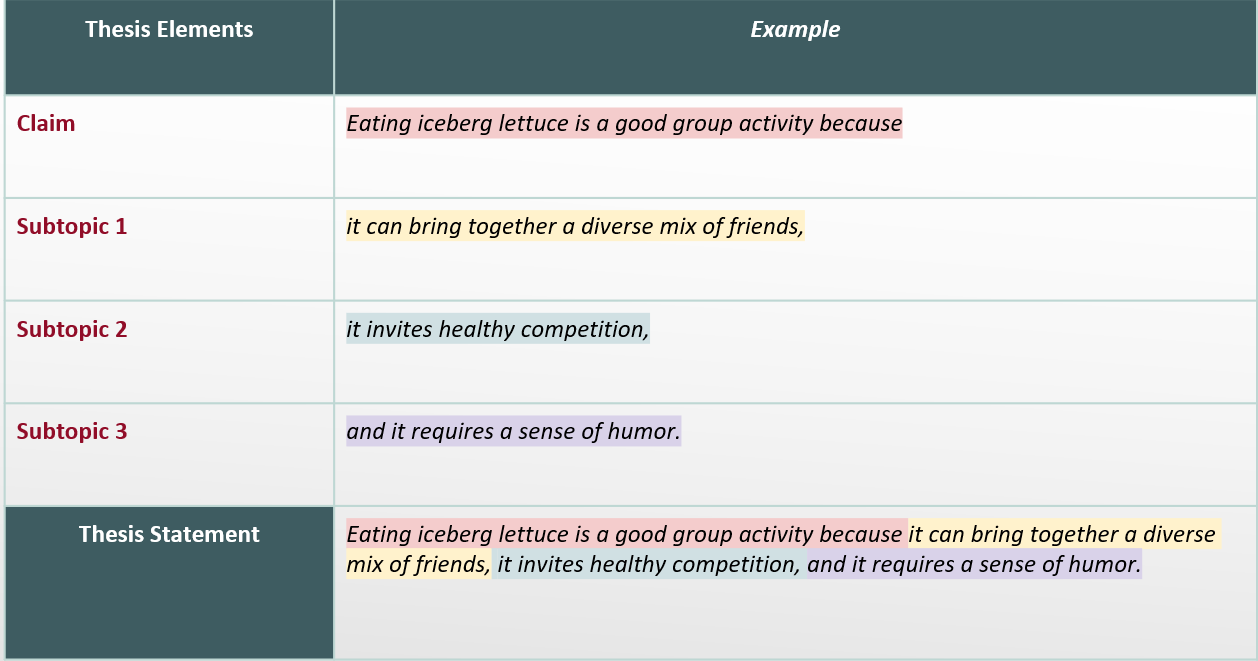Summary
Is lettuce interesting? The answer depends on whom you ask. Whether the subject of lettuce is personally captivating or not, a good essay on the subject requires a thesis statement to organize the text and to keep the reader oriented and focused. A strong thesis statement not only helps the reader, but also provides a structure to assist the writer in finding relevant information on specific topics. In this lesson, students practice writing a thesis statement based on an article about a Texas high school’s Lettuce Club.
Essential Question(s)
In what ways can a piece of writing be clear and purposeful for the reader?
Snapshot
Engage
Students watch a video about a Texas school's "lettuce eating" club and form a claim about the club.
Explore
Students read and annotate an article about lettuce-eating clubs and re-evaluate their claim.
Explain
Students use both the video and article to support points for writing a thesis statement.
Extend
Students state an opposing claim supported by new subtopics to consider how to support another argument.
Evaluate
Students complete one of three exit tickets in order to reflect on building strong thesis statements or writing a new thesis statement for a specific writing task.
Materials
Lesson Slides (attached)
Writing a Thesis Statement handout (attached; one per student)
Lettuce Club Road Map (attached)
"Lettuce Club helps students have fun, Romaine calm during testing." (Article on Lettuce Challenge, linked)
Writing a Thesis Statement video (linked)
Engage
Show slide 3.
Show the Edpuzzle video clip that has been edited for time and content: People Try the Lettuce Challenge (use the Edpuzzle clip).
After students watch the video, ask them to discuss their stance on the "lettuce challenge: " Do you think this challenge is harmless or is it best avoided?
Show slides 4-5 to help students guide their processing these questions in order to state a claim.
Pass out copies of the Writing a Thesis Statement handout to each student. Advise them that the handout will be used for several activities throughout the lesson. After they have watched the "People Try the Lettuce Challenge" video, have them write a claim following the directions on the "Writing a Claim" portion of the handout page 1. If needed, refer to slide 5 again as students write. Help individual students as needed.
After students have had time to write their claims, reiterate that an essential part of a piece of writing is the writer’s claim — a statement that explains their position clearly.
Show slide 6. Review the Essential Question: In what ways can a piece of writing be clear and purposeful for the reader?
Either pause for responses to this question or leave the slide up for students to consider and reflect on to answer later. This question will be revisited at the end of the lesson.
Show slide 7. Review the Lesson Objectives:
Analyze a topic or question to formulate a stance that informs a clear claim.
Synthesize relevant subtopics to support a claim.
Write a thesis statement that could be used in a research paper or expository essay.
Explore
Once students have created a claim related to the Lettuce Challenge, it's time to continue building a case for this claim by introducing a more robust context with additional information.
Explain the following concepts about evidence and reasoning: (1) a claim is made stronger when it clearly expresses a position and when that position can be discussed; (2) ample information is required in order to promote discussion of a claim; (3) information can come from a range of resources, like articles, experience, and video.
Ask students to read "Lettuce Club helps students have fun, Romaine calm during testing," the article about students who started a Lettuce Club at their high school.
Before students read the article, show slide 8 to introduce the S-I-T (Surprising, Interesting, Troubling) strategy to use during reading. If they are skilled in annotating texts, this will be a comfortable strategy to extend that skill. Ask students to look for and take notes on the following while they are reading the article:
What did they learn that is surprising?
What did they learn that is interesting?
What did they learn that is troubling?
Have students summarize their annotations on page 1 of the Writing a Thesis Statement handout in the S-I-T strategy section.
After students have recorded their annotations from the Lettuce Club article using the S-I-T strategy, ask them to revisit the claims they made in the Engage activity. These claims were written in response to the "People Try the Lettuce Challenge" Buzzfeed video.
Ask students whether, after reading the article, they still agree with their claims. Invite them to explain why or why not. Have them discuss with an Elbow Partner or as a whole class whether or not they agree with that claim and why. As students discuss their claims, remind them that evaluating a claim is an important part of the process of understanding the strength of an argument or position.
Explain
Once students have practiced writing and evaluating claims informed by different sources, introduce the concept of how their claims fit into a thesis statement. Show the Writing Road Map infographic on slide 9.

Point out to students where a thesis statement fits into the process of composing an essay: (1) a thesis statement condenses the main topic and the supporting points into one sentence; (2) the sentence is effective because it communicates the main point efficiently and clearly to the reader; (3) the thesis statement provides a structure, a kind of mini outline, that guides the writer; (4) the thesis statement introduces and structures both the topic for the essay and the main points of subsequent body paragraphs.
Show the thesis video linked on slide 10. Advise students that a thesis statement has a claim and three topics (for our purposes) that they must support with evidence and reasoning.
Show slide 11. Ask students to consider why having one sentence like a thesis statement would accomplish (1) efficiency; (2) clarity; and (3) structure.
Have students revisit the sources explored so far about school Lettuce Clubs, the Buzzfeed video, and the Newsela article. Have them discuss as a class how a thesis statement inspired by those sources might look.
Show slide 12. Show the Buzzfeed video a second time.
Show slide 13. When the video has concluded, ask students to review the thesis statement for that video on page 2 of the Writing a Thesis Statement handout.
Ask them to look at the color-coded statements on the slide. Walk them through the construction of the thesis statement. The thesis statement includes a claim inspired by the content of the video and three subtopics related to the claim. The claim and subtopics are listed below and found on slide 13.

Ask students to consider the three subtopics that support the claim, which states that eating iceberg lettuce is a good group activity. The final thesis statement is below:
Eating iceberg lettuce is a good group activity because it can bring together a diverse mix of friends, it invites healthy competition, and it requires a sense of humor.
Ask students to consider how these subtopics support the claim. Explain that if this thesis statement were structuring an actual essay, it would be at the end of the introduction and each of these subtopics would be topics for the subsequent body paragraphs. Show slide 14 that illustrates this outline flow.
Once students have worked through the process of developing a thesis statement, ask them to practice writing their own thesis statement. Have them craft a claim and subtopics using the Lettuce Club article.
Before moving to the next step, take time to clarify misconceptions and answer questions about what a thesis statement is and how one is written. As needed, revisit slides that illustrate this information clearly.
Once the class is ready to move on, revisit the "Lettuce Club helps students have fun, Romaine calm during testing." After they have read the article, have them use page 2 of their handout to state a claim and form three subtopics related to the claim.
Have students develop a complete thesis statement either individually or in small groups for this. Schedule at least 20 minutes for this activity, judging how much more or less time is needed based on discussions and questions.
Once students have their thesis statements written, ask them to share their work: (1) present a claim that states their position; (2) present three subtopics and describe how each supports the claim; (3) present their full thesis statement.
Extend
To reinforce the process, have students state an opposing claim and find three new subtopics for the opposing side of the Lettuce Club article. Have them use page 3 in the Writing a Thesis Statement handout. Have students work either individually or in groups.
After students have completed their opposing claim activity, have the class come back together for a whole group discussion to share out what they discovered by looking at the issue from opposing points of view.
Evaluate
Display the Exit Ticket on slide 15. The evaluation for this lesson can be modified to assess students applying thesis statements already written in this lesson or their taking the new knowledge and applying it to create a new thesis statement. The options below cover a range of needs:
Exit Ticket 1: Tips for building a strong thesis statement: If you do not have a writing project requiring a thesis statement coming up, have students submit their tips for writing a strong thesis statement. These tips can be grouped according to themes and used to create an anchor chart or to see what "clicked" with students and what information needs to be revisited.
Exit Ticket 2: Thesis statement for upcoming research paper: If you have a research paper or essay assignment planned after teaching this lesson, this lesson evaluation option is an open-ended opportunity for students to form their own claims and draft original thesis statements. This could be an opportunity to introduce that next topic and use that applied knowledge as an evaluation for this lesson or as a simple exit ticket where students write a claim based on the resource shared (related video, article, photo, blurb, etc. related to upcoming topic).
Exit Ticket 3: Thesis statement for upcoming research paper: If you want to continue the theme from this lesson, introduce an essay prompt that is related to school clubs. Much research exists on secondary school initiatives run by students, information on what clubs/groups exist, what’s needed, why, etc.
Resources
BuzzFeed Video. (2016, July 6). People try the lettuce challenge. [Video]. YouTube. https://www.youtube.com/watch?v=za-WknY7lMQ
K20 Center. (n.d.). Bell Ringers and Exit Tickets. Strategies. https://learn.k20center.ou.edu/strategy/125
K20 Center. (n.d.). Claim, Evidence, Reasoning (CER). Strategies. https://learn.k20center.ou.edu/strategy/156
K20 Center. (2021, Aug. 19). Claims, Evidence, and Reasoning. [Video]. YouTube. https://www.youtube.com/watch?v=JGOxVIgmGWE
K20 Center. (n.d.). Debate Team Carousel. Strategies. https://learn.k20center.ou.edu/strategy/110
K20 Center. (n.d.). EdPuzzle. Tech Tools. https://learn.k20center.ou.edu/tech-tool/622
K20 Center. (n.d.). Elbow Partners. Strategies. https://learn.k20center.ou.edu/strategy/116
K20 Center. (n.d.). Google Classroom. Tech Tools. https://learn.k20center.ou.edu/tech-tool/628
K20 Center. (n.d.) Honesty is the best policy? 5E Lessons. https://learn.k20center.ou.edu/lesson/1469
K20 Center. (n.d.). Newsela. Tech Tools. https://learn.k20center.ou.edu/tech-tool/649
K20 Center. (n.d.). S-I-T (Surprising, Interesting, Troubling). Strategies. https://learn.k20center.ou.edu/strategy/926
K20 Center. (2021). Writing a thesis statement. [Video]. YouTube. https://www.youtube.com/watch?v=qWb2zbVl-rot - YouTube
Light, N. (2018, June 12). Lettuce Club helps students have fun, Romaine calm during testing. Newsela.com. https://newsela.com/read/elem-lettuce-club/id/44163/?search_id=d85ba583-1ee7-4fef-9232-b8d97ca436cd




